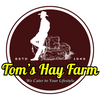California’s 2030 climate goals are encouraging farmers and ranchers, including Tom’s Hay Farm, to adopt carbon farming practices that sequester carbon in the soil. Techniques like cover cropping and reduced tillage could improve soil health and provide incentives through programs like California’s Healthy Soils Program (HSP). However, for small farms producing hay and feed for dairy farms, implementing these practices involves significant costs and challenges that could affect hay production and prices. Here’s a look at the potential benefits and drawbacks.
Cover cropping — planting grasses or legumes between hay harvests — can capture carbon, enhance water retention, and reduce erosion. Reduced tillage minimizes soil disturbance, preserving carbon and lowering fuel use. These methods could make our land more resilient to drought and improve long-term yields. The HSP offers grants to support farmers adopting these practices, with additional funding for projects that measure carbon benefits. Healthier soil could lead to higher-quality hay, benefiting our dairy and ranch customers. Some farmers are also exploring carbon credit markets for additional revenue, though these markets remain complex and volatile.
However, carbon farming presents challenges for small farms. Cover crops require seeds, labor, and water, which are costly. Equipment for reduced tillage, such as no-till drills, involves significant investment, and changing established routines demands time and expertise. For hay farms like ours, cover cropping could reduce the number of harvests per year, potentially decreasing output and increasing prices for customers. While HSP grants are available, they’re competitive, with only 25% of funding allocated to research-intensive projects. Small farms often lack the resources to handle the required paperwork or monitor carbon sequestration, and benefits may take years to materialize.
The broader implications are also concerning. If carbon farming reduces yields, we may need more land to maintain production, a challenge given the pressures of urban development on farmland. Widespread adoption could drive up hay prices. California aims to sequester millions of tons of CO2 by 2030, but experts note that measuring carbon storage is complex, and gains may not be permanent if practices change.
At Tom’s Hay Farm, we’re carefully evaluating the benefits — improved soil health and potential incentives — against the costs and risks. We’d welcome your input: visit our store or contact us to share your thoughts on carbon farming and how we can support our farming community.



